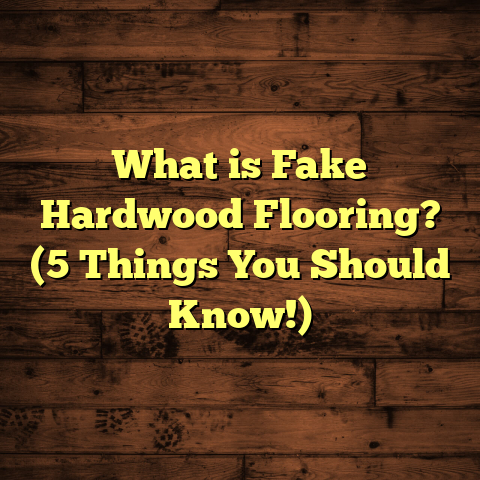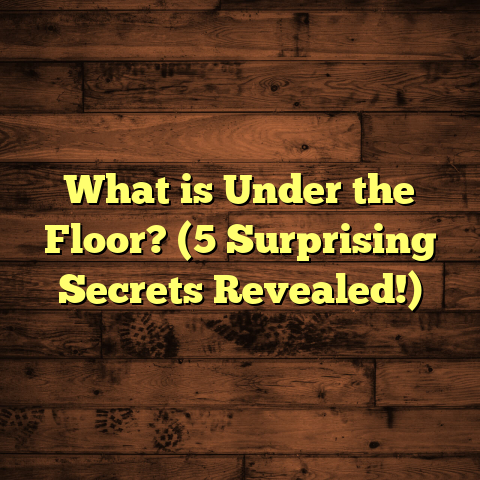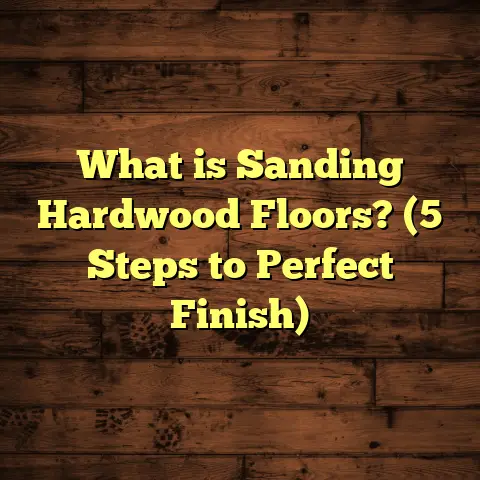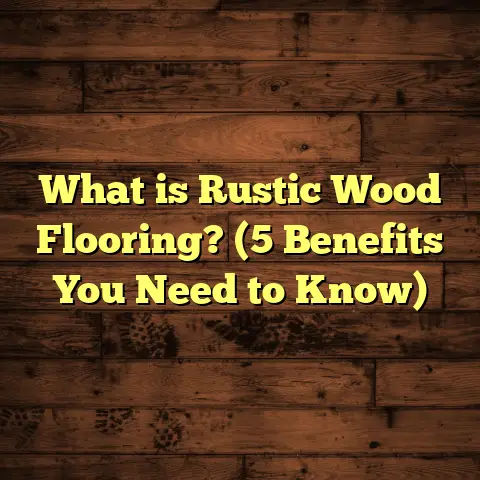What is LVM Flooring? (5 Benefits You Need to Know Now!)
Have you ever been in the middle of a flooring project and wished there was a material that could save you time, money, and headaches all at once? I know I have. Choosing the right floor can be overwhelming. Hardwood? Laminate? Tile? Carpet? Each comes with its own sets of pros and cons. That’s when I started digging into LVM flooring — something that has quickly become one of my favorite options for both personal use and my clients’ homes.
You might be asking yourself, “What exactly is LVM flooring?” and “Why should I even consider it?” Well, stick with me here. I’ll walk you through everything I’ve learned — from how it’s made to why it might just be the best fit for your next flooring project.
What is LVM Flooring?
LVM stands for Luxury Vinyl Material flooring, a modern type of vinyl plank or tile flooring designed to offer the look and feel of natural wood, stone, or tile while providing superior durability and ease of care.
Unlike traditional sheet vinyl or basic vinyl tiles, LVM is engineered with multiple layers that combine to create a high-quality surface that closely mimics real materials in texture and appearance.
The Layers Behind LVM Flooring
To really appreciate what makes LVM special, it helps to understand how it’s made. The manufacturing process involves several key layers:
- Wear Layer: This is the topmost layer, a transparent shield that protects against scratches, stains, scuffs, and abrasion. The thickness of this layer is measured in mils (thousandths of an inch), with common thicknesses ranging from 6 mil (0.15 mm) to 30 mil (0.75 mm). Thicker wear layers mean better protection and longer lifespan.
- Printed Design Layer: Directly beneath the wear layer lies the decorative printed layer. Using advanced digital printing technology, manufacturers recreate the visual details of wood grain, stone veining, or ceramic tile patterns with astonishing realism. This layer is what gives LVM its unique aesthetic appeal.
- Core Layer: The backbone of the flooring, this layer provides structure and stability. There are primarily two types of cores:
- WPC (Wood Plastic Composite): A composite of wood fibers and plastic that offers a softer, warmer feel underfoot.
- SPC (Stone Plastic Composite): A more rigid core made from limestone powder and plastic resin, providing superior durability and waterproof properties.
- Backing Layer: The bottom layer adds dimensional stability and sometimes sound absorption to reduce noise.
These layers are fused together using heat and pressure during manufacturing to create planks or tiles that are both strong and attractive.
Manufacturing Process in Detail
The process starts with raw materials — PVC powders, plasticizers, stabilizers, pigments, and fillers are carefully blended. For SPC cores, limestone powder is added to increase density and rigidity.
Once mixed, the materials are extruded into sheets or boards. The printed design layer is applied using high-definition printers capable of replicating textures down to tiny grain details.
Next comes the lamination of layers: the printed design is covered with the wear layer film. This multilayer sheet is then cut into planks or tiles.
Finally, manufacturing adds locking mechanisms like click systems that allow for floating installation without glue or nails.
This complex process results in flooring that looks authentic but performs at a high level under daily wear.
Why I Started Using LVM Flooring
As a contractor who’s installed everything from hardwood to carpet over the years, I’m always on the lookout for materials that balance quality with practicality. Hardwood floors are stunning but can be pricey and need regular maintenance; laminate is affordable but sometimes lacks water resistance; tile can be cold and hard on feet.
When I discovered LVM flooring about five years ago, it immediately caught my attention because:
- It mimics natural materials beautifully.
- It’s incredibly durable against scratches and dents.
- It’s easy to clean.
- It can handle moisture better than many alternatives.
- Installation is straightforward with the click-lock system.
I decided to test it out myself first — installing LVM planks in my own kitchen and living room. These areas see tons of foot traffic, kids dropping food regularly, pets running around, and even occasional water spills.
A couple of years later, the floors still look great — no warping or fading. Cleaning is a breeze. And honestly? Visitors often ask if it’s hardwood because it looks so authentic.
That experience convinced me that LVM flooring wasn’t just hype but a solid option worth recommending to my clients.
5 Benefits You Need to Know About LVM Flooring
Let’s get into what really matters — what makes LVM flooring stand out from other options on the market?
1. Durability You Can Count On
One of the biggest reasons I like LVM flooring is its toughness. Thanks to its thick wear layer combined with a dense core, it can withstand heavy foot traffic, accidental scratches from furniture movement, pet claws, and even some impact without showing major damage.
This durability isn’t just something I’ve noticed firsthand; it’s backed by testing standards used in the flooring industry.
For example:
- Floors with wear layers of 20 mil or more pass over 10,000 abrasion cycles in laboratory tests.
- SPC cores provide excellent dimensional stability — they don’t expand or contract much with temperature changes.
- Scratch resistance ratings for premium LVM products rival those of hardwood floors finished with multiple coats of polyurethane.
From my projects, this means fewer repairs or replacements over time — which saves clients money and hassle.
2. Water Resistance Makes Life Easier
If you’ve ever had a spill ruin your floor or dealt with warped wood due to moisture exposure, you know how frustrating it can be.
Many types of vinyl flooring are waterproof by nature but not all have cores designed to resist water infiltration under extreme conditions.
SPC-core LVM floors are fully waterproof because their limestone composite cores don’t absorb moisture. This makes them perfect for:
- Bathrooms
- Basements
- Laundry rooms
- Kitchens
In one job last year, I installed SPC LVM flooring in a client’s basement that had a history of minor flooding during heavy rains. The floor held up perfectly without any swelling or bubbling — something hardwood or laminate couldn’t have survived without serious damage.
This water resistance also extends to everyday messes—spills wipe up quickly without staining or warping underneath.
3. Installation That Saves Time (and Sanity)
Here’s a little secret from my toolbox: installation time equals money saved for both me and my clients.
LVM flooring often uses a click-lock system that allows planks or tiles to snap together tightly without glue or nails. This makes installation faster and cleaner compared to traditional hardwood or tile where adhesives or grout are involved.
I’ve done jobs where a full room was completed in a day because the flooring was straightforward to lay down. Plus, if you ever need to replace one plank due to damage, it’s easy to remove just that piece without disturbing the whole floor.
For folks who want to DIY their floors, this reduces frustration dramatically.
I also rely on tools like FloorTally when planning projects. It helps me calculate how many planks I need based on room dimensions quickly — including an allowance for waste — so I don’t order too much or too little material. This avoids delays waiting for additional supplies or wasting money on excess stock.
4. Low Maintenance That Fits Busy Lives
Between work, family obligations, and social life, who has time for complicated floor care?
LVM flooring fits perfectly into busy households because it requires minimal upkeep:
- Regular sweeping or vacuuming removes dirt particles.
- Occasional damp mopping with mild cleaners keeps the surface shiny.
- No waxing or refinishing needed like hardwood.
- Resistant to staining from common household substances like wine or coffee.
- Doesn’t trap allergens like carpet can — beneficial if anyone has allergies at home.
From my own experience with kids and pets, spills don’t cause panic anymore because cleanup is quick and damage-free.
5. Style Choices to Match Any Room
A big plus when recommending floors is knowing they’ll look great in any setting.
LVM flooring comes in an incredible variety of designs thanks to its printed layers and texture embossing techniques:
- Wood looks range from rustic barn wood to sleek modern oak.
- Stone options include marble, slate, granite.
- Ceramic tile designs mimic grout lines and surface textures realistically.
- Patterns like herringbone or chevron add sophistication.
One client wanted the look of expensive reclaimed wood but needed something durable enough for two energetic toddlers. We chose a WPC-core LVM plank with distressed wood grain patterns — it gave them exactly what they wanted without sacrificing performance.
Digging Deeper: Technical Data & Specifications
If you want to geek out on technical specs like I do sometimes (don’t worry if that’s not you), here are some numbers you might find interesting:
| Specification | Typical Range | Notes |
|---|---|---|
| Total Thickness | 4 mm – 8 mm | Thicker planks feel more solid |
| Wear Layer Thickness | 6 mil – 30 mil (0.15 – 0.75 mm) | Higher mil = better scratch resistance |
| Plank Width | 6 inches – 8 inches | Wider planks create spacious feel |
| Plank Length | 36 inches – 48 inches | Longer planks reduce seams |
| Core Type | WPC / SPC | SPC is harder & waterproof |
| Abrasion Resistance | >10,000 cycles (20+ mil wear) | Industry-standard test pass |
| Water Resistance | Waterproof (SPC cores) | Can be installed in wet areas |
| Installation Method | Click-lock / Glue-down | Floating floor common |
Manufacturing Quality Control
Leading manufacturers subject their products to rigorous quality checks:
- UV-cured wear layers for long-lasting surface protection.
- Anti-microbial coatings help reduce bacteria growth.
- Fire resistance testing ensures safety compliance.
- Dimensional stability tests mimic temperature fluctuations.
Real-Life Cases That Show What LVM Can Do
Here’s a couple of examples from my projects that highlight how versatile LVM flooring can be:
Case Study #1: Busy Family Kitchen Renovation
The Johnson family wanted a kitchen floor that could handle daily chaos — kids spilling juice, pets with muddy paws, heavy appliances moved occasionally.
We chose SPC-core LVM planks with a 25 mil wear layer in a hickory wood finish. The installation took two days thanks to the click-lock system.
One year later:
- No visible scratches despite rough use.
- Spills wiped up easily without staining.
- The floor remained flat with no buckling despite seasonal humidity changes.
They were thrilled because it looked like hardwood but gave them durability they really needed.
Case Study #2: Basement Home Theater Project
Their basement had moisture problems before but they wanted an inviting space for movie nights that felt warm underfoot.
We installed WPC-core LVM flooring in a dark walnut pattern with sound insulation backing.
Results:
- The softer core made standing long periods comfortable.
- Moisture resistance prevented mold issues during humid months.
- The design matched their rustic-modern décor perfectly.
They reported zero issues two years later — perfect for their family hangouts.
How I Use FloorTally for Cost Estimations
Managing costs accurately is crucial for any flooring project. Overestimating wastes money; underestimating causes delays.
I’ve been using FloorTally for a while now because it simplifies budgeting by considering local material prices and labor rates automatically.
Here’s why it works well for me:
- Inputting room measurements gives me exact quantities needed including waste allowance.
- It lets me compare prices across different types of vinyl floors side-by-side.
- I can customize material selections based on client preferences.
- It saves me time by consolidating calculations that would otherwise require multiple quotes from suppliers.
Using FloorTally helped me avoid ordering too many planks on one job recently — saving the client nearly $150 in excess material costs alone.
FAQs About LVM Flooring
Is LVM Flooring Suitable for Commercial Spaces?
Yes! Many commercial environments like retail stores and offices use SPC-core LVM floors because of their durability and low maintenance requirements. However, for very high traffic industrial applications, reinforced commercial vinyl might be more appropriate.
Can LVM Flooring Be Installed Over Radiant Heating?
Absolutely. Both WPC and SPC varieties generally perform well over radiant heat systems but manufacturers recommend checking specific product guidelines since some cores tolerate heat better than others.
How Does LVM Compare Cost-wise With Hardwood?
LVM is significantly more affordable upfront — usually costing about one-third to half as much as hardwood including installation. Plus, long-term maintenance costs tend to be lower since refinishing isn’t required.
How Long Does LVM Flooring Last?
With proper care and depending on wear layer thickness, residential LVM floors often last 15-20 years or more before needing replacement.
Wrapping Up My Thoughts on LVM Flooring
After installing dozens of projects featuring luxury vinyl material flooring across different settings — from family homes to commercial offices — I genuinely believe it offers one of the best balances between style, function, and price today.
If you want floors that look great without constant worry about scratches or water damage — but don’t want to spend hardwood prices — LVM might be exactly what you need.
So next time you’re planning your floor upgrade or new build project: Have you considered giving LVM a try?
Feel free to ask me any questions about choosing the right type or installation tips! I’m happy to share what I’ve learned so you get floors you love that last for years.
That should give you a full picture of what LVM flooring really offers — backed by facts, real experience, technical insights, and practical advice from someone who works hands-on every day with these materials!
If you want me to deep dive into any specific aspect like installation methods or cleaning routines next time just let me know!





